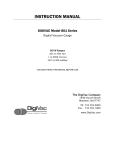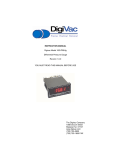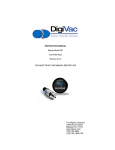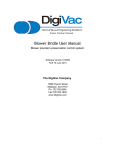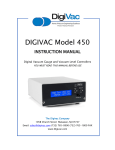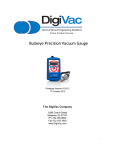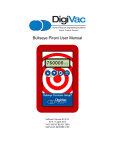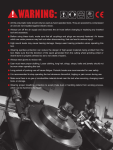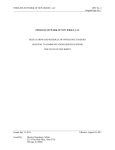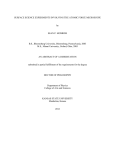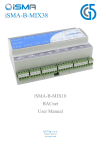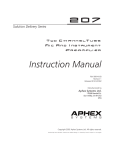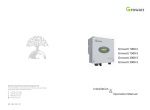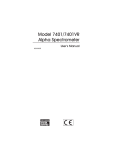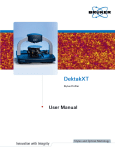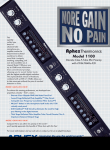Download Model LEDBAR Instruction Manual
Transcript
INSTRUCTION MANUAL DIGIVAC LightBarVac Digital Vacuum Gauge with Progressive LED visual indication YOU MUST READ THIS MANUAL BEFORE USE millitorr 1 10 50 100 1000 ATM The DIGIVAC Company 105B Church Street Matawan NJ 07747 www.DIGIVAC.com (732) 765-0900 (732) 765-1800 FAX CONTENTS 1.0 Description and Principle of Operation. 2.0 Construction. 3.0 Unpacking and Inspection. 4.0 Installation. 5.0 Operation. 6.0 Servicing and Calibration. 7.0 Notes on Calibration. 8.0 Understanding Microns, Torr, and Absolute Pressure. 9.0 Accessories and Modifications 10.0 Attachments and Illustrations. 11.0 Terms & Conditions DIGIVAC LightBarVac Instruction Manual Page 2 1.0 DESCRIPTION AND PRINCIPLE OF OPERATION. The DIGIVAC LightBarVac is a visual digital vacuum control instrument that is designed to be extremely easy to use. This device can simplify process work by giving a progressive visual indication of vacuum pressure that is easy to remember from across the room. It also features Cylon set points that make it very obvious when a particular vacuum level is reached. If in doubt about what gauge sensor you have, consult the DIGIVAC packing list that came with your instrument for positive identification. Consult the DIGIVAC website www.DIGIVAC.com for information about other DIGIVAC vacuum controllers and gauges. The DIGIVAC LightBarVac configured with a Varian 531 Thermocouple gauge tube senses vacuum by measuring the temperature rise of an electrically heated thermocouple exposed to a vacuum. As vacuum increases, or, more correctly, as absolute pressure decreases, fewer and fewer molecules of gas are available to cool the thermocouple. With fewer molecules the air temperature rises and the thermocouple gauge thus senses the vacuum. A precision reference inside the DIGIVAC in conjunction with an integrated circuit amplifier controls the electrical excitation of the sensor filament 2.0 CONSTRUCTION. The DIGIVAC consists of the indicating and controlling instrument, the sensor configured, the sensor cable, the output interfaces and an international AC power adapter. The instrument is housed in a rugged free-standing vinyl clad metal enclosure. The gauge tube houses the various thermocouple sensing, heating and compensating elements and terminates in an octal connector. On this model, the connector wiring terminates at the instrument with a 6 position RJ24. Regulating circuitry in the DIGIVAC provides constant current for gauge tube excitation, and thus compensates for resistance in the probe leads. 3.0 UNPACKING AND INSPECTION. After the instrument is received, it should be carefully unpacked and inspected for damage during shipment and for completeness. The package should contain, as a minimum, the instrument, the sensor and cable ordered, an AC power adapter and an instruction manual. In the event of a loss during shipment, a claim should immediately be made to the common carrier or the postal service, as applicable. The DIGIVAC warranty pertains only to the instrument, and does not cover losses in shipping. Each LightBarVac should come with: o User Manual (this document) o Display controller (black box) o Power supply o Sensor and cable 4.0 INSTALLATION. The instrument should be located in a clean, dry environment for best results. DIGIVAC LightBarVac Instruction Manual Page 3 Thermocouple gauge tubes must be installed in a thread-down orientation in a clean, dry vacuum system. While threading the gauge tube in to the manifold, the gauge tube cable should be disconnected to avoid damage. In this way, twisting of the cable and the octal socket on the tube is avoided. Care should be exercised to install the tubes in a dry part of the system. Since the instrument works on the principle of temperature rise, the probes will not work if they become filled with a liquid such as vacuum or diffusion pump oil. The gauge tube should be protected against oil and other contaminants by installing it in such a way to protect it. A good practice is to mount the gauge tube in the most vertically distant place from oil and other contaminants as applicable. The gauge tube should be mounted in the most stable pressure region of the vessel to be measured. For example, it would be better to install the gauge tube on a tank rather than on the pipe that is directly connected to a vacuum pump. In the event of contamination, see section 6.0 for gauge tube cleaning instructions. If the gauge is used in a Neon sign processing facility, the following is recommended to protect the gauge from damage from bombarding: The gauge tube should be isolated from the system with a stopcock. The stopcock should be closed when bombarding. There should be at least 2 feet of tubing between the electrode and the DIGIVAC. For best results, the tubing should be metal. In extreme cases, the gauge can be absolutely protected by installing a normally open solenoid valve between the gauge tube and the system. The solenoid valve coil should be in parallel with the bombarding transformer. In this way, the solenoid will be closed and the gauge tube will be positively protected whenever bombarding is done. If a gauge is damaged by bombarding, it can generally be brought back to operating condition by replacing the Op amp which controls the gauge tube current. Consult DIGIVAC. 5V ON Set Point Sensor Power OFF The set point recessed button is used to set the set point. The sensor wire plugs into the jack labeled “sensor”. The power adapter plug plugs into the jack labeled “Power”. Although it is not necessary, you may turn the unit off. Please use the supplied 5V AC adapter with your Instrument. This adapter provides clean short protected power to protect and insure accuracy of the internal circuitry. 5.0 OPERATION. After installation, the DIGIVAC is ready for immediate operation. The unit will normally provide accurate readings immediately; when used with a thermocouple gauge however, occasionally a gauge tube will have absorbed material during storage and may require as much as 24 hours of operation before accurate readings are attained. It is recommended that the DIGIVAC be energized continuously during vacuum system operation. In this way, the hot filament will not allow contaminants to condense. Only connect and disconnect cables with the power to the unit unplugged. Make connection to sensor with the power disconnected. NEVER DISCONNECT SENSOR WIRES WHILE UNIT IS POWERED UP. DIGIVAC LightBarVac Instruction Manual Page 4 In cases where the system has contaminants, as is often the case with metalizing and coating equipment, it is often effective to isolate the gauge tube with a solenoid or manual valve during periods when contamination is most active. millitorr 1 10 50 100 1000 ATM The operation of the LightBarVac is simple: simply plumb the sensor in, connect the cables and start reading Vacuum. When exposed to atmospheric pressure, all 30 LEDs will be lit. As the vacuum is applied, the number of LEDs will reduce indicating the current pressure. The right most green LED indicates the current pressure. When the left most LED blinks, the instrument is indicating below 1 millitorr. The DigiVac LightBarVac has 1 visual Cylon set point that can be used to visually indicate a vacuum pressure of interest. To set this set point: 1. Attain vacuum level that you would like the set 2. Push recessed switch in the back of the unit labeled “set point” for 1 second a. The set point is now entered. When a vacuum pressure at or below the set point is attained, the LEDs to the left of the current pressure LED will Cylon back and forth (think of the red light movement of the battle star galactic Cylon robots or the red light movement in the Knight rider car) b. To disable set points, set for any pressure for over 400000 microns (400 Torr or Atmosphere) 6.0 SERVICING - GAUGE TUBE CLEANING. In many cases, a gauge tube may become fouled with oil or other foreign matter. It is often possible to restore the functionality of contaminated probes with cleaning. If the contaminant is known, the tube should be filled with a fluid that is known to be a solvent to that contaminant. As an example, ether is often effective in removing residues of some oils. Commercial carburetor cleaners are very powerful solvents and are highly effective against some contaminants. After cleaning with solvents, the gauge tube should be completely dried or flushed with a volatile solvent to assure that it is dry prior to re-installing it. If this is not done, contamination of the system may result. 6.1 FACTORY REPAIR AND CALIBRATION. The vacuum gauge assembly is designed to provide years of trouble-free service, and the liberal internal use of plug-in components make it easily repairable. No field servicing of the unit is recommended, other than replacement of the gauge tube, but factory servicing and calibration are available at a nominal cost and turn-around times of 24 hours are typical. 6.2 FIELD CALIBRATION. Each DIGIVAC vacuum gauge controller is calibrated to the particular vacuum gauge sensor that is shipped with the unit. While changing the gauge tube is possible, it will result in a slightly different reading as all gauge tubes are not created equal. Although it is preferable that all calibration be performed at DIGIVAC, field calibration can be accomplished. DIGIVAC LightBarVac Instruction Manual Page 5 Before re-calibrating the instrument, it should be ascertained that the instrument is in fact incorrect. In many cases, the problem will be with a tube that is fouled, or a system that is operating improperly. It is recommended that a spare tube be kept on hand and stored in a clean, dry place. Then, in cases of suspect readings, the tube should be changed before proceeding further. If adjustments are to be made for thermocouple vacuum gauges, proceed as follows: A) Remove the Instrument from the panel. B) Remove the front panel cover of the instrument and locate the two calibration potentiometers. The “Zero” potentiometer is to the right as you look at the LED Display, the “ATM” or span adjust is to the left closest to the outside of the board. C) Precalibrate a. Set the device on a table top with the tube plugged in b. Place a voltmeter lead on ground (center pin below display) c. Place the positive voltmeter lead on the lower side of the beige capacitor on the top of the board to the left of the display d. Adjust the Zero POT to read 1.77 Volts e. Place the Positive voltmeter lead in the via that is located on the left side of the board towards the edge f. Adjust the span pot so the voltage is 1.185 Volts D) Operate the vacuum system at the lowest attainable pressure, and allow the system and the gauge tube to stabilize for several minutes. Factory zero setting is done at a pressure of .1 millitorr (.1 micron) or less. E) Adjust the zero setting potentiometer so the unit reads zero. Make sure not to under span. Allow the measurement standard to rise to 1 millitorr and make sure the gauge reading also reads 1 millitorr. (Note the POTS are counter intuitive, clockwise makes the value go down and vice versa, and are very sensitive...) F) Check the operation of the gauge at other pressures. Normally, adjustment of the zero will not be interactive with the readings of the instrument at higher pressures. G) The ATM adjustment is normally not necessary. If necessary, adjust the span with the ATM potentiometer. a. For the 201H set the vacuum level to a steady 1980 millitorr, and slowly turn the potentiometer on the right until the DIGIVAC gauge reads 1980 millitorr b. For the 201V, set the vacuum level to Atmosphere (approximately 760 Torr) and slowly turn the potentiometer on the right until the DIGIVAC gauge reads 760 Torr, being careful not to over span. c. If you adjust the span, recheck the zero, then the span, and the zero one last time. 7.0 NOTES ON CALIBRATION. The DIGIVAC is calibrated in nitrogen, which has thermal properties virtually identical to air. If you are using a thermocouple vacuum gauge, other gasses will affect the readings by an amount proportional to the thermal conductivity of the gases. In most cases, the gases present in a vacuum system will be air, nitrogen, or oxygen, and no appreciable errors will occur. Certain other gases, however, have thermal conductivity significantly greater than air and will cause the instrument to read higher than the actual amount of pressure. Examples of such gasses are water vapor, fluorocarbon refrigerants, and acetone. Conversely, other gasses have thermal conductivity significantly lower than air and will cause the instrument to read lower than actual pressure. Examples of such gasses include helium, oxygen and to a lesser extent, CO2. When interpreting readings using gasses other than air, it should be borne in mind that the DIGIVAC reads Torr, which is a measure of absolute pressure - that is the opposite of vacuum. Thus, a lower numerical reading actually is a higher level of vacuum. For more information, refer to section 8.0. Note that isolated transducers like capacitance manometers are independent of gas type. DIGIVAC LightBarVac Instruction Manual Page 6 8.0 UNDERSTANDING TORR. The DIGIVAC and many similar instruments are calibrated in microns or "millitorr." It is appropriate to discuss what microns are and to relate microns to other measures of pressure and vacuum. Microns are not really a measure of vacuum at all, but rather of absolute pressure. It will be recalled that the pressure of the atmosphere is 14.696 or approximately 14.7 pounds per square inch at sea level. This pressure is due to the weight of all of the air in the earth's atmosphere above any particular square inch. This 14.696 psi is equivalent to the pressure produced by a mercury column of approximately 29.92 inches high or .76 meters (about 3/4 of a yard) or 760 millimeters of mercury. Atmospheric pressure varies greatly with altitude. It decreases approximately 1 inch of mercury per thousand feet of altitude. It also varies widely with local weather conditions. (Variations of one half inch in a single day are common.) The word vacuum means pressure lower than atmospheric or "suction," but, in describing negative pressure, the atmosphere is only a satisfactory reference if we are dealing with values of vacuum down to about 27 inches of mercury. Below that, it is much more useful to talk in terms of absolute pressure, starting from absolute zero. The DIGIVAC and all similar instruments do just this. One TORR, a commonly used unit, is an absolute pressure of one millimeter of mercury. A millitorr is equal to one thousandth of a TORR. A MICRON is the same as a millitorr. The full scale reading of a DIGIVAC is 1999 microns and is equivalent to 1.999 TORR of approximately 2/760 of atmospheric pressure. This is less than .1 inches of mercury, and less than .05 PSI. DIGIVAC LightBarVac Instruction Manual Page 7 9.0 ACCESSORIES AND MODIFICATIONS. The following are offered as accessory equipment or field-installed modifications. Padded shoulder strap Case with Velcro closure- For instruments that will be used in the field, particularly in cryogenic applications, a padded shoulder strap case is available. This case holds a DIGIVAC 100tc battery powered gauge in the optimal reading position. The operator can open the Velcro cover, pull out the gauge tube cable, plug it into the tube on the equipment, and see the reading. It was developed to assist in field service of cryogenic tank farms and vacuum jacketed piping. COMPATIBILITY WITH OTHER GAUGE TUBES. On special order, DIGIVAC Instruments can be provided to use with most other vacuum gauge tubes. AC and DC excitation are available. Gauges have been provided for Hastings, Varian, Thermionics, Veeco, VRC, and Fredericks gauge tubes. DIGIVAC LightBarVac Instruction Manual Page 8 10.0 Attachments and Illustrations. LEDs L-R Pressure LE <= State '1-1 '1-2 '1/2 1-1 0.0005 blink off 0 1 0.0010 on off 1 2 0.0020 h-on on 2 3 0.0030 h-on h-on 3 4 0.0050 h-on h-on 4 5 0.0070 h-on h-on 5 6 0.0100 h-on h-on 6 7 0.0100 h-on h-on 7 8 0.0400 h-on h-on 8 9 0.0500 h-on h-on 9 10 0.0600 10 h-on h-on 11 0.0700 11 h-on h-on 12 0.0800 12 h-on h-on 13 0.0900 13 h-on h-on 14 0.1000 14 h-on h-on 15 0.2000 15 h-on h-on 16 0.3000 16 h-on h-on 17 0.4000 17 h-on h-on 18 0.5000 18 h-on h-on 19 0.6000 19 h-on h-on 20 0.7000 20 h-on h-on 21 0.8000 21 h-on h-on 22 0.9000 22 h-on h-on 23 1.0000 23 h-on h-on 24 2.0000 24 h-on h-on 25 5.0000 25 h-on h-on 26 10.0000 26 h-on h-on 27 20.0000 27 h-on h-on 28 200.0000 28 h-on h-on 29 400.0000 29 h-on h-on 30 760.0000 30 h-on h-on '1-3 off off off on h-on h-on h-on h-on h-on h-on h-on h-on h-on h-on h-on h-on h-on h-on h-on h-on h-on h-on h-on h-on h-on h-on h-on h-on h-on h-on h-on '1-4 off off off off on h-on h-on h-on h-on h-on h-on h-on h-on h-on h-on h-on h-on h-on h-on h-on h-on h-on h-on h-on h-on h-on h-on h-on h-on h-on h-on '1-5 off off off off off on h-on h-on h-on h-on h-on h-on h-on h-on h-on h-on h-on h-on h-on h-on h-on h-on h-on h-on h-on h-on h-on h-on h-on h-on h-on '1-6 off off off off off off on h-on h-on h-on h-on h-on h-on h-on h-on h-on h-on h-on h-on h-on h-on h-on h-on h-on h-on h-on h-on h-on h-on h-on h-on '1-7 off off off off off off off on h-on h-on h-on h-on h-on h-on h-on h-on h-on h-on h-on h-on h-on h-on h-on h-on h-on h-on h-on h-on h-on h-on h-on '1-8 off off off off off off off off on h-on h-on h-on h-on h-on h-on h-on h-on h-on h-on h-on h-on h-on h-on h-on h-on h-on h-on h-on h-on h-on h-on '1-9 off off off off off off off off off on h-on h-on h-on h-on h-on h-on h-on h-on h-on h-on h-on h-on h-on h-on h-on h-on h-on h-on h-on h-on h-on '1-10 off off off off off off off off off off on h-on h-on h-on h-on h-on h-on h-on h-on h-on h-on h-on h-on h-on h-on h-on h-on h-on h-on h-on h-on '2-1 off off off off off off off off off off off on h-on h-on h-on h-on h-on h-on h-on h-on h-on h-on h-on h-on h-on h-on h-on h-on h-on h-on h-on '2-2 off off off off off off off off off off off off on h-on h-on h-on h-on h-on h-on h-on h-on h-on h-on h-on h-on h-on h-on h-on h-on h-on h-on '2-3 off off off off off off off off off off off off off on h-on h-on h-on h-on h-on h-on h-on h-on h-on h-on h-on h-on h-on h-on h-on h-on h-on '2-4 off off off off off off off off off off off off off off on h-on h-on h-on h-on h-on h-on h-on h-on h-on h-on h-on h-on h-on h-on h-on h-on '2-5 off off off off off off off off off off off off off off off on h-on h-on h-on h-on h-on h-on h-on h-on h-on h-on h-on h-on h-on h-on h-on '2-6 off off off off off off off off off off off off off off off off on h-on h-on h-on h-on h-on h-on h-on h-on h-on h-on h-on h-on h-on h-on DIGIVAC LightBarVac Instruction Manual Page 9 '2-7 off off off off off off off off off off off off off off off off off on h-on h-on h-on h-on h-on h-on h-on h-on h-on h-on h-on h-on h-on '2-8 off off off off off off off off off off off off off off off off off off on h-on h-on h-on h-on h-on h-on h-on h-on h-on h-on h-on h-on '2-9 off off off off off off off off off off off off off off off off off off off on h-on h-on h-on h-on h-on h-on h-on h-on h-on h-on h-on '2-10 off off off off off off off off off off off off off off off off off off off off on h-on h-on h-on h-on h-on h-on h-on h-on h-on h-on '3-1 off off off off off off off off off off off off off off off off off off off off off on h-on h-on h-on h-on h-on h-on h-on h-on h-on '3-2 off off off off off off off off off off off off off off off off off off off off off off on h-on h-on h-on h-on h-on h-on h-on h-on '3-3 off off off off off off off off off off off off off off off off off off off off off off off on h-on h-on h-on h-on h-on h-on h-on '3-4 off off off off off off off off off off off off off off off off off off off off off off off off on h-on h-on h-on h-on h-on h-on '3-5 off off off off off off off off off off off off off off off off off off off off off off off off off on h-on h-on h-on h-on h-on '3-6 off off off off off off off off off off off off off off off off off off off off off off off off off off on h-on h-on h-on h-on '3-7 off off off off off off off off off off off off off off off off off off off off off off off off off off off on h-on h-on h-on '3-8 off off off off off off off off off off off off off off off off off off off off off off off off off off off off on h-on h-on '3-9 off off off off off off off off off off off off off off off off off off off off off off off off off off off off off on h-on Below is the typical response of a thermocouple vacuum gauge tube. DIGIVAC gauges which use pressure transducers are linear. MilliTorr 0 5 10 20 25 35 50 75 100 150 200 300 500 750 1000 1500 1900 Millivolts 10 9.57 9.32 8.81 8.54 8.11 7.46 6.63 5.96 5.04 4.38 3.56 2.72 2.24 1.97 1.71 1.59 DIGIVAC LightBarVac Instruction Manual Page 10 11.0 TERMS AND CONDITIONS . TERMS OF USE, LIMITED WARRANTY & LIABILITY WAIVER THE DIGIVAC COMPANY (“DIGIVAC”) offers all of its products with the following terms and conditions and notices as follows. By accepting and/or using a DIGIVAC product, you hereby acknowledge and agree to the following terms and conditions, and acceptance of these terms and conditions are a condition precedent to any purchase/sale agreement between you and DIGIVAC. EXCLUSIVE OBLIGATION: The DIGIVAC product you are purchasing has been designed for a specific use within a set of suitable operating conditions, as set forth in its User Manual, or as indicated otherwise by DIGIVAC. Any use of the DIGIVAC Product for any purpose or under any conditions, other than those specified, shall render any limited warranty void, and shall expressly invalidate any liability of DIGIVAC for damages as a result of such misuse. USER LIMITATION: You may not modify, copy, distribute, transmit, display, perform, reproduce, publish, license, create derivative works from, transfer, or sell, any information, software, products or services obtained from or created by DIGIVAC to any third party, without the express written consent of DIGIVAC to do otherwise. Any violation of this provision shall give rise to an indemnification of DIGIVAC by you, for any third party claims arising out of such violation. THIRTY (30) DAY LIMITED WARRANTY: All DIGIVAC products are warranted against any manufactured defect for a period of thirty (30) days from date of purchase, unless such product is a custom-work for you and not a standard DIGIVAC product. Any product qualifying as a custom-work shall not be warranted against any defects for any purpose, and your acceptance of such custom-work shall relieve DIGIVAC of any liability for any purpose. WITH THE EXCEPTION OF THE LIMITED WARRRANTY ABOVE, YOU AGREE ANY DIGIVAC PRODUCT IS PROVIDED AS IS, EXCLUSIVE OF ANY WARRANTY, INCLUDING, WITHOUT LIMITATION, ANY IMPLIED WARRANTY OF MERCHANTABILITY, FITNESS FOR A PARTICULAR PURPOSE, NON-INFRINGEMENT, OR ANY OTHER WARRANTY, EXPRESSED OR IMPLIED. LIMITATION OF LIABILITY: You agree and acknowledge, DIGIVAC shall have no liability to you whatsoever for any direct, indirect, punitive, incidental, special consequential damages arising out of or connected with the use or misuse of its products. In particular, given the nature of DIGIVAC products, you agree and acknowledge, under no circumstances whatsoever shall DIGIVAC be liable to you for any consequential damages for damage to any non-DIGIVAC product or service, arising from the failure, use or misuse of a DIGIVAC product, including, but not limited to, any vacuum system, engine, vehicle, factory, or the like. In the event, a court of law with proper jurisdiction finds DIGIVAC liable to you for any purpose, you agree and acknowledge DIGIVAC’s maximum liability shall not exceed the purchase price of one unit of product giving rise to such liability, or $250.00, whichever is greater. ENTIRE OBLIGATION: These terms and conditions express the entire obligation of DIGIVAC with respect to its products. If any part of these terms and conditions are deemed void, invalid, unenforceable or illegal, including, but not limited to, the warranty disclaimers, liability disclaimers and liability limitations set forth above, then the unenforceable clause or sentence may be disregarded with the remainder of these terms and conditions valid and enforced. In the event the unenforceable clause or sentence leaves a void in these terms and conditions, a provision closely matching the intent of the unenforceable provision should be deemed inherent within these terms and conditions, slightly modified to render such provision valid and enforceable. GENERAL: These terms and conditions are governed by the laws of the State of New Jersey, USA. You hereby consent to the exclusive jurisdiction and venue of the Courts of New Jersey, in all disputes arising out of or relating to the use of this product. Use of this product is unauthorized in any jurisdiction that does not give effect to all provisions of these terms and conditions. MODIFICATION OF TERMS AND CONDITIONS: DIGIVAC reserves the right to change the terms, conditions, and notices under which their products are offered. DIGIVAC LightBarVac Instruction Manual Page 11











